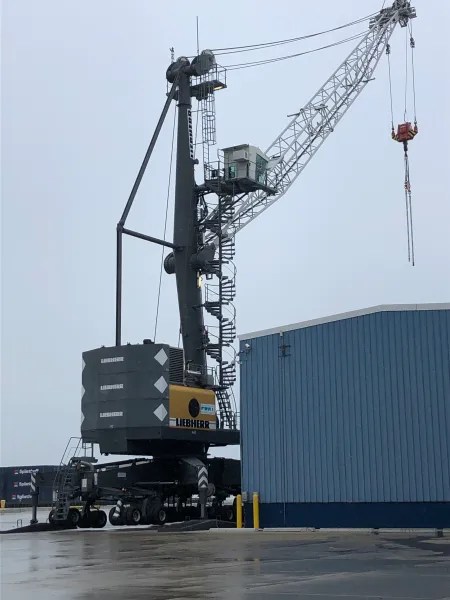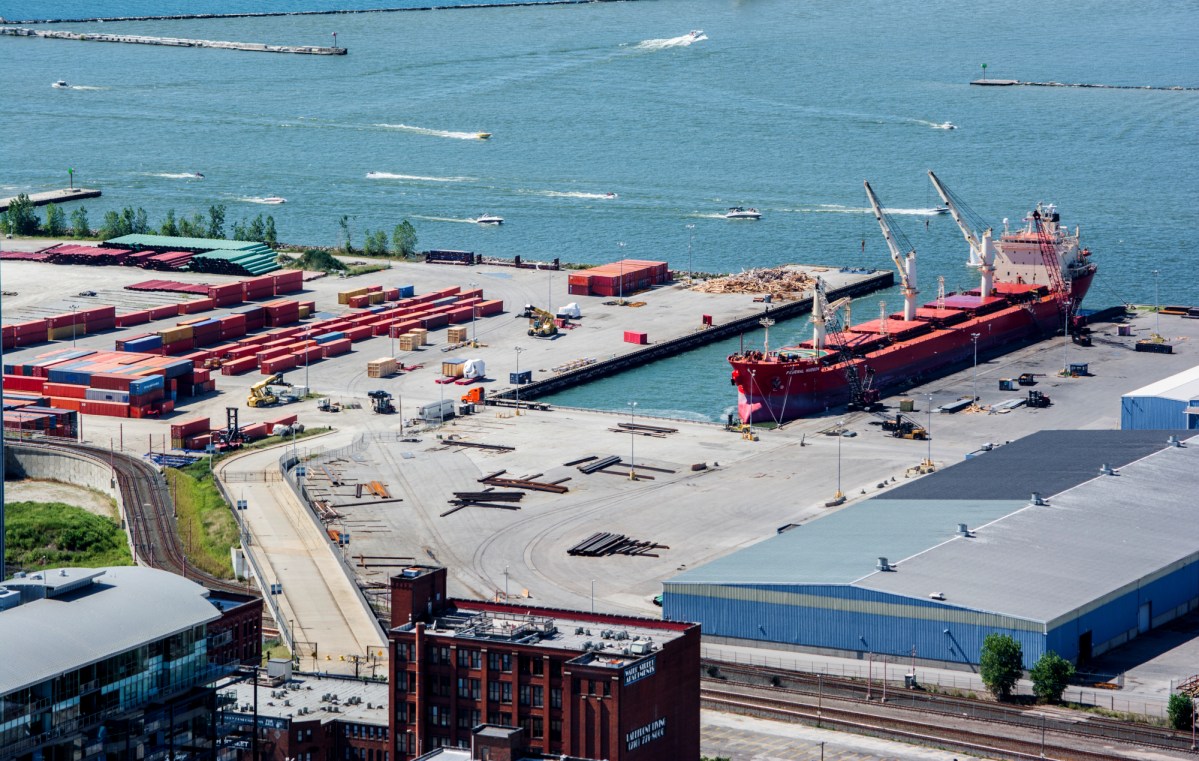The Port of Cleveland is going electric.
One of the Great Lakes’ largest shipping ports is transforming part of a large warehouse into an “electrification hub” to anchor its emission-cutting efforts in the coming decades.
The project is among the Cleveland-Cuyahoga Port Authority’s first steps toward its goal of net-zero emissions for its own operations by 2050. The target does not include “Scope 3” emissions from the ships, trains, and trucks that come and go from the port, but officials hope the upgrades will support their emissions cuts as well.
“Upgrading the electric feed into the terminal is not the most exciting thing,” said Carly Beck, the port’s senior manager for planning, environment and information systems, but it’s a necessary foundation for all other parts of the port authority’s climate plan.
Shipping ports are a major source of not only climate emissions but also harmful air pollution for nearby communities. Fossil fuels power most of the cranes, vehicles, and other equipment used to move commodities and consumer goods around the globe. The United Nations estimates that global shipping is responsible for about 3% of emissions worldwide.
The Cleveland-Cuyahoga County Port Authority became the first port on the Great Lakes to announce a net-zero emissions goal when its board unanimously approved its climate action plan last September. In February, the board approved spending $32 million from state and federal transportation grants to modernize the warehouse and make electrification upgrades.
Cleveland’s downtown port on Lake Erie handles about 13 million tons of cargo each year, from steel and iron ore to wind turbine parts and heavy machinery. Most goes to or comes from parts of Ohio and neighboring states via rail or truck.
“Lake Erie … sits at a very important position geographically as part of the Great Lakes,” said Dana Rodriguez, a senior analyst on global shipping at the Environmental Defense Fund.
The Cleveland-Cuyahoga County Port Authority, like many of its U.S. counterparts, is a public entity that owns and maintains infrastructure at the port. It contracts with a commercial operating company, Logistec, to run day-to-day operations.
The port considered multiple approaches for cutting greenhouse gas emissions, including hydrogen power, before deciding to focus its efforts on electrification, Beck said. All told, the port estimates full electrification will require roughly 5 to 7 megawatts of available power, she said. Design work for modernization and the electrification hub at the port’s Warehouse A is underway.
The port also is working with Logistec on a grant application for funds under the U.S. EPA’s Clean Ports Program, set up under the 2022 Inflation Reduction Act. Roughly $2.8 billion in competitive grants are available for deploying zero-emission technology, with an additional $150 million for climate and air quality planning. The application is due May 28.
If successful, the port plans to add 2 megawatts of solar capacity on top of Warehouse A, which will provide a significant chunk of its anticipated electrical needs. Other funds would be used to start acquiring electric equipment for port operations, such as a large forklift.

Over time, the port plans to acquire additional equipment as and when machinery and funds become available, including replacements for a large crane and other material-handling equipment.
“It’s just a matter now of biting off chunks as we can,” Beck said. Timing for the acquisitions will also depend on when different types of electrical equipment become available, which will involve ongoing review.
Port Authority President and CEO Will Friedman said the electrification push fits with the port’s broader sustainability goals, including reducing water pollution in Lake Erie and managing dredged material more sustainably.
“We’re doing it because it’s the right thing to do. We have a social conscience here,” Friedman said.
The decision also should help the port stay competitive, especially as more companies consider the indirect emissions of their contractors.
“We think that’s going to be the future if you’re part of the supply chain network,” Friedman said, adding that ignoring greenhouse gas emissions really isn’t an option. “All industries are trying to figure out how they can decarbonize, and maritime shipping is certainly a part of that.”
The bigger picture
Decarbonization makes sense for Cleveland and Cuyahoga County in the global scheme of things, said Grant Goodrich, executive director for the Great Lakes Energy Institute at Case Western Reserve University.
“Getting products in and out of Europe and being able to advertise and market that you can do it in a more emissions-friendly manner gives you a competitive advantage,” Goodrich said. The European Union already is pushing for the shipping sector to cut greenhouse gas emissions, and Goodrich expects that will ultimately become important in the American marketplace as well. Cutting greenhouse gases also could help attract more cruise ship business to Cleveland, he added.
The port’s regional nature likely will make some aspects of decarbonization easier. For starters, the port generally does not store fuel for ships on site. Ships typically fill up elsewhere, often from barges, depending on where they believe they can get the best deal, Friedman said. If a ship does need extra fuel while in Cleveland, trucks deliver it.
On the other hand, the Cleveland-Cuyahoga County Port Authority has less bargaining power than some much larger ports on the East and West coasts. That limits its ability to increase fees, which makes grants and other types of funding particularly important.
The Cleveland-Cuyahoga Port Authority’s focus on Scope 1 and Scope 2 emissions is consistent with the goals for a majority of other ports included in a March 2024 report from the Environmental Defense Fund and Arup. However, the report noted, the majority of total port emissions driving human-caused climate change generally are not within ports’ direct control and would fall into Scope 3.
“Action in the broader zone of user and community and industry influence, where impacts are often far greater and where potential benefits are significant, is lacking,” the EDF report said.
The Cleveland-Cuyahoga County Port Authority’s upgrades include planning to provide power for some of those other indirect emissions.
“We don’t want to forget about Scope 3,” Beck said.
She added that the port anticipates offering incentives to encourage ships and others to reduce their emissions.
An example would be for ships to plug into electrical shore power, known as “cold ironing,” instead of running diesel engines while in port. Besides cutting greenhouse gas emissions, the process can also reduce pollution from particulate matter, nitrous oxides, hydrocarbons and carbon monoxide. The port also hopes to encourage independent operators to acquire electric tugboats and similar equipment.
“Port decarbonization is just one key piece of the full decarbonization equation,” said Rodriguez at the Environmental Defense Fund. “It is also up to the trucking and shipping sectors to meet the ports halfway and contribute to the decarbonization efforts. In an effort to reach net zero by 2050, all stakeholders must play their part.”

